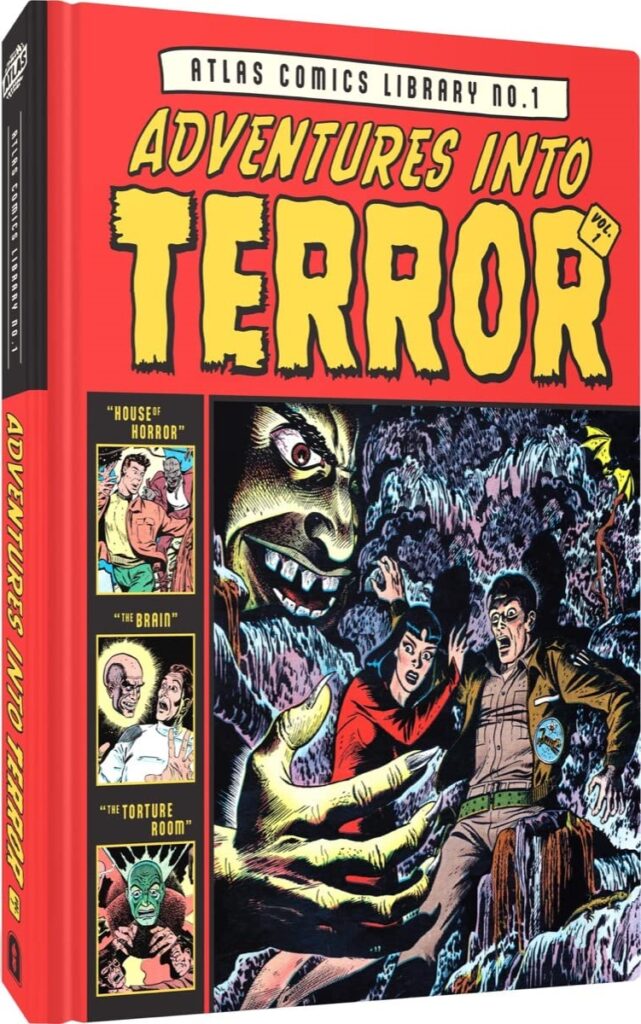
The mainstream American comic book is the home of the super-hero. But that was just its final evolution. While the comic market was forming from the ’30s through the ’50s, there was an enormous variety of genres. Comics derived from the pulps, and many publishers put out both short story magazines and comic books. There were crime pulps, science fiction pulps, horror pulps, romance pulps, and so there were lines of comic books just as diverse.
What led to the narrowing of focus in America to basically just superhero comics is a long story. But before Marvel became the premiere superhero comic publisher, it was called Atlas comics. Atlas printed a wide variety of genres, including the horror anthology Adventures into Terror. In the first of their Atlas Comics reprint line, Fantagraphics has released a hardcover reprint of the first eight issues of this series.
These eight issues, coming from 1950 to 1952, include four or five stories per issue. Each story ranges from about eight pages to as little as two, though there’s usually one longer story, then three or four backups, four or five pages long. The genre is generally horror fantasy. Though it came out 10 years before, think along the lines of Twilight Zone, but simpler and with more weird monsters. Rich jerks getting their supernatural comeuppance. Poor sad sacks finding themselves in trouble beyond explanation. Strange circumstances have even stranger explanations.
There are 36 comic stories in this collection, and a 37th two-page text story filling out one issue. The quality of the writing varies pretty wildly. The art, for the most part, is pretty great. It is of its time and place, with the pretty straightforward semi-cinematic style of the era. Most stories begin with a half-page splash panel (sometimes totally unrepresentative of the actual story.) Then most pages have around six panels, with cinematic dynamism in the graphic storytelling.
By and large, the art is better than the writing. The stories involve haunted houses, revenge from beyond the grave, and mad scientists whose experiments go out of control. Some stories depart from the norm. “You Can’t Escape” is a weird meta-narrative about a vampire who commissions his own story in an issue of Adventures into Terror, just so the reader is so enthralled he doesn’t see the monster sneak up on him. “Find Me” involves an advertising artist who gets so engrossed in his art he ends up drawing himself into it and can’t get out.
Of the more conventional stories, “The Storm” and “Joe…” where two I enjoyed the most. “The Storm” involves that hoariest of conventions, a couple caught in the rain who have to take refuge in an old spooky house. They find an old couple there, who after showing them to the dining room disappear almost at once. The house is immense, seemingly much larger on the inside than the out. Every room contains some nightmare, and they can never find their way out… not until, years later, another couple comes in from a storm.
“Joe…” is a weird tale about a joke that takes on a life of its own. The protagonist jokes he has an invisible friend, Joe, who does his bidding. It’s a dull kind of joke… until it starts coming true. He wishes someone would break their leg, it happens. He tells a colleague to get lost. The colleague disappears.
Maybe the best story is “Where Monsters Dwell”. Here, a mad scientist, angry at an editorial writer bashing him in the press, using some kind of beam to send that writer to another world. In that other world, the writer’s face becomes twisted and strange, and he meets other twisted enemies of the scientist. They all hope to come back to Earth, catching the scientist’s beam that forms the bridge between worlds.
These are, of course, very old-fashioned comics. How could they not be? They’re old. These stories were meant to frighten pre-teens in the ’50s. As horror to a contemporary audience, they might not fit the bill. But I found the stories fun, and occasionally pretty creepy. Not much is original (and what’s original, the few stories I mentioned above notwithstanding, is not much good) but it’s a fitting example of the spirit of the comics of the time. Some stories have the clear feeling of existing to fill space, but there’s a lot of worthwhile stuff, too. And refreshingly there’s only a low level of moralizing, which is often the bane of this sort of horror/fantasy storytelling.
This series is being edited by Dr. Michael J. Vassalo, a comic historian. The book opens with his illuminating essay on the history of Atlas Comics and these comics in particular. He’d previously put together the compilation Atlas at War for the U.S. Naval Institute, with the comics sourced from his own collection.
Typical of Fantagraphics, it’s a beautifully produced book. Besides the comics, there are several vintage advertisements (presumably from the original magazines), giving the contemporary flavor of the books. Retailing at about $35, it’s clearly for enthusiasts of the era. But I found the stories enjoyable. It’s in full color, unlike Fantagraphics similar EC Artists library (which I also collect and enjoy.) This volume of Adventures into Terror is a fun read and great introduction to what I hope is a long series of valued reprints.
Atlas Comics Library No. 1: Adventures into Terror Volume 1 has been released by Fantagraphics.